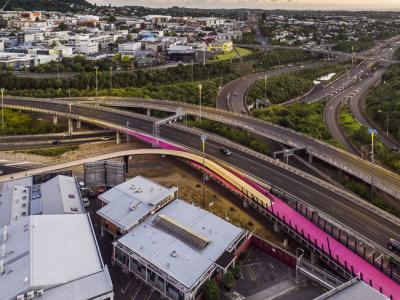GHD, 27 June 2016 - Auckland’s new landmark Te Ara I Whiti (Lightpath) cycleway has been recognised as one of New Zealand’s best public works projects.
The project team of New Zealand Transport Agency, GHD, Novare Design, Monk Mackenzie and Hawkins has received the Excellence Award in the category Best Public Works Project > $5M from the New Zealand division of the Institute of Public Works Australasia.
These prestigious awards showcase projects that are not only completed on time and on budget, but also achieve clearly defined community outcomes.
The Lightpath project converted the unused Nelson Street Off Ramp into a vital 1 km long link for cyclists and pedestrians around the Auckland CBD. According to the judges, it’s a ‘spectacular response’ to NZ Transport Agency’s vision for developing world-class cycling infrastructure throughout each major city and town.
The project also includes a 160 m steel bridge that snakes over New Zealand’s busiest highway junction. It was constructed entirely off site and lifted into place during overnight closures.
The project created an iconic piece of Auckland infrastructure famous for its magenta surface, Maori artwork and 290 interactive LED lights.
With an extremely positive response from the public and cycling groups, and an average of 935 cycle trips per day, the NZ Transport Agency is confident that the project is already providing a drawcard for businesses in the local area.
The design was developed with the safety and efficiency of the state highway, local road network and pedestrians/cyclists in mind.
Gansen Govender, GHD’s Design Manager and Engineer’s Representative, says, ”Normally, a project of this complexity would take well over two years to deliver, but the team worked collaboratively to deliver this cycleway in only 14 months from scheme to completion”.
“The tight timeframe and budget for the works might have encouraged the delivery of a completely practical solution. Instead, the project team evolved the design into an iconic urban structure that’s used and appreciated by many Aucklanders.”

